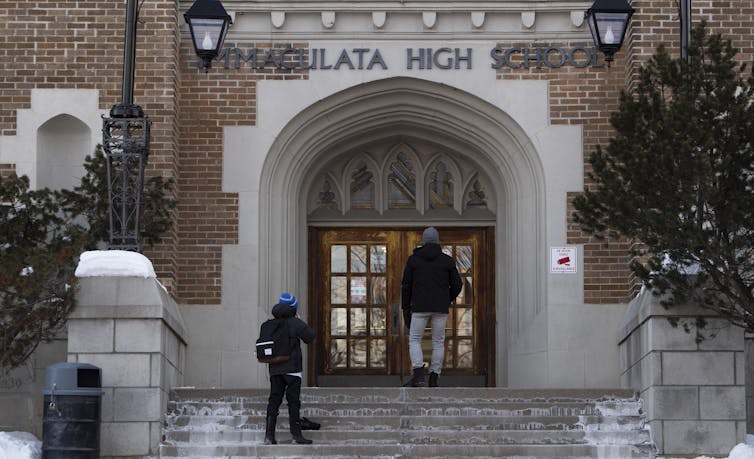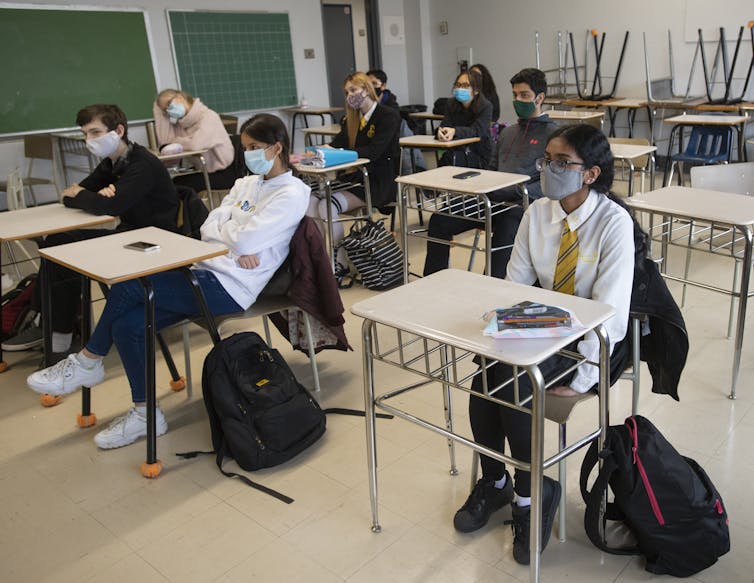
As COVID-19 restrictions recede across much of the world, students have navigated changes in modes of learning (from virtual to in-person) and social protocols (for example, no masks).
Even as societies gradually return to normal, we are constantly reminded that COVID-19 is still very much in our communities. Regions are no longer reporting publicly on COVID-19 cases, but in schools, the continued circulation of the virus still means the possibility of ongoing extended absences for both teachers and students.
In response to pandemic schooling challenges, schools and school boards have implemented policies to minimize the negative impact of COVID-19 on students’ grades. Some have frozen students’ grades based on windows of uninterrupted learning, or made exams optional.
Yet the inconsistencies in these policies has undoubtedly led to challenges in terms of equity and fairness. Some high school students have voiced concerns about how their post-secondary choices could be affected as a result. University students have also raised issues about the fairness of grades.
The learning and assessment connection
A key priority in education is to provide children and youth with the opportunity to learn and to demonstrate that learning. As researchers who explore the role of assessment, student outcomes and education policy, we know that assessment matters not only to monitor students’ ongoing progress, but also to report on that progress and inform future instructional and educational decisions.
COVID-19 has been a reminder of the important factors that are beyond students’ control that influence achievement. It has put disparities between disadvantaged students and their more affluent peers into sharper focus: for example, educators have witnessed the learning barriers and inequities some students have faced due to differences in internet connectivity or supportive home learning environments.
À lire aussi : Student achievement depends on reducing poverty now and after COVID-19
Given these challenges, educators have sought alternate ways to provide students with opportunities to learn and to fairly report on that learning.
Despite these efforts, researchers project that COVID-19 has resulted in lower levels of learning in math and literacy in grade school students. If these trends are accurate, similar concerns could be valid for senior secondary school students.

Grade inflation?
It’s also likely that shifts in grading and reporting practices have led to significant grade inflation. Some anecdotal evidence from teachers we’ve talked to suggests students’ grade distributions have shifted, with increases in both higher and lower grades, and fewer “average” grades in the middle. This could be one sign of inequities exacerbated by the pandemic related to lost hours at school and with teachers.
Mainstream western education systems are largely driven by grading systems. Students use grades to determine if they have the skills and abilities to predict the likelihood of success in subsequent years. They use grades to direct their future education choices, and teachers are aware of this.
Rightly or wrongly, secondary school students are caught in a competitive learning environment. Letter grades and percentages are most commonly used to report student achievement in ways that significantly impact their futures.
The pass/fail alternative
Teachers have continually wrestled with the negative impacts of grades, wanting students to focus on learning rather than being consumed with attaining marks. Long before the pandemic, education researchers have criticized commonly used methods of grading that can entrench a competitive focus and negatively impact students’ learning.
One approach to address the inconsistencies in students’ grades during the extraordinary circumstances of the COVID-19 pandemic has been to shift to pass/fail grading. This approach has been most commonly seen in some university programs which already had a history of pass/fail grading.
Studies show that pass/fail grading is fair and can help students and teachers focus on learning. Concerns that pass/fail grading leads to less student effort can be resolved through clearer learning expectations for achievement, and by creating a learning environment where each student is able to succeed.

Since the start of the pandemic, pass/fail grading has increased with prominent examples in both the United States and Canada.
The University of Alberta, for example, moved to a credit/no-credit system where no grades were assigned for courses in winter 2020. Brock University presented students with options to choose between a letter-based or numeric grade; a designation of “credit during disruption” or “no credit during disruption;” or a “withdrawal during disruption” without academic penalty.
Pass/fail university admissions?
There has also been a recognition of pass/fail grades for university and college admissions, especially in the United States where high-stakes examinations, secondary grades or a combination have long been the primary methods to determine university entrance. Some school districts have shifted to optional pass/fail grades, and some post-secondary institutions have started to recognize pass/fail grades for admissions purposes.
What would a shift to pass/fail grading mean for university admission? It would require using other forms of information such as personal statements, reference letters and for students to demonstrate critical thinking and communication skills.
Even before the pandemic, such practices were used alongside grades for admissions. They do require additional effort by students, and by those in charge of post-secondary admissions. Nevertheless, given that more than half of Canada’s universities had graduation rates below 75 per cent prior to the pandemic, the previous reliance on secondary school grades could hardly be considered foolproof.

After the pandemic
It is unlikely classrooms will look the same after this pandemic. COVID-19 has required students to take greater ownership of their learning, and both students and parents have expressed becoming more attuned to children’s learning needs.
At the same time, teachers have had to more clearly articulate what students need to accomplish to demonstrate their learning.
It’s possible that COVID-19 has created an opportunity to revise our focus on student grading and reporting, to ensure our educational systems can better focus on learning and help students’ identify the learning expectations they have, and those they still need to develop.
Don A. Klinger has previously received funding from the Social Sciences and Humanities Research Council in Canada. Currently he serves as an advisor to the Education Quality and Accountability Office (EQAO) in Ontario, and as a technical advisor to Immigration, Refugees and Citizenship Canada (IRCC) and to the New Zealand Quality Assurance (NZQA).
Corrie has previously received funding from, Kentucky Teacher Intern Program Grant, Commonwealth of Kentucky ($411,446), Teacher Quality Enhancement Grant ($411,446), Teacher Education Model Programs Grant from Kentucky ($714,000), Kentucky Center for Economics Education, and Teaching with Primary Resources from the Library of Congress USA. And is affiliated with the Consortium for Research on Educational Assessment and Teaching Effectiveness, the Joint Committee on Standards for Educational Evaluation and the Pegasus Institute.
Louis Volante receives funding from the Social Sciences and Humanities Research Council of Canada (SSHRC).
This article was originally published on The Conversation. Read the original article.







